Chemistry and Biochemistry Report: Carbohydrate and Fat Metabolism
VerifiedAdded on 2020/05/16
|11
|1544
|260
Report
AI Summary
This report delves into the complexities of carbohydrate and fat metabolism, examining key processes such as glycolysis, the citric acid cycle, gluconeogenesis, electron transport chain, oxidative phosphorylation, and beta-oxidation. The report analyzes the metabolic pathways involved in breaking down complex biomolecules into glucose, the primary fuel source for the body, and discusses the role of the pancreas and liver in glucose metabolism. It further explores the case of John, whose diet consists of carbohydrate-rich meals and junk food with unhealthy fats and refined carbohydrates, leading to overweight and potential diabetes risk. The report examines how John's eating habits contribute to an energy imbalance and the impact of insulin resistance on glucose regulation. Furthermore, the report highlights the connection between John's consumption of processed and fried foods, insulin resistance, and the development of diabetes. The report also discusses the role of lipid accumulation, the imbalance between fatty acid uptake and beta-oxidation, and their impact on insulin resistance. Overall, the report emphasizes the link between John's dietary choices, the metabolic processes involved, and his increased risk of developing diabetes.
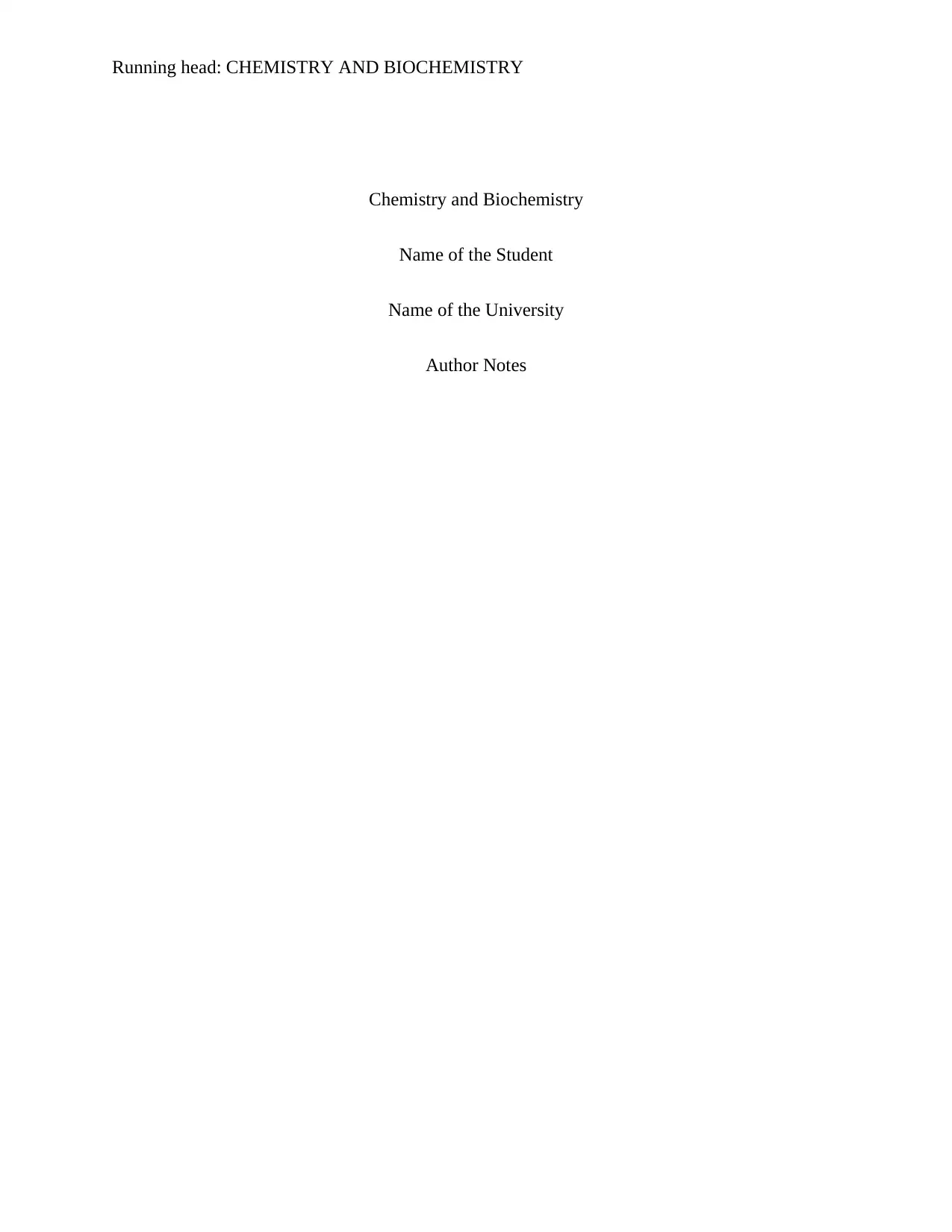
Running head: CHEMISTRY AND BIOCHEMISTRY
Chemistry and Biochemistry
Name of the Student
Name of the University
Author Notes
Chemistry and Biochemistry
Name of the Student
Name of the University
Author Notes
Paraphrase This Document
Need a fresh take? Get an instant paraphrase of this document with our AI Paraphraser
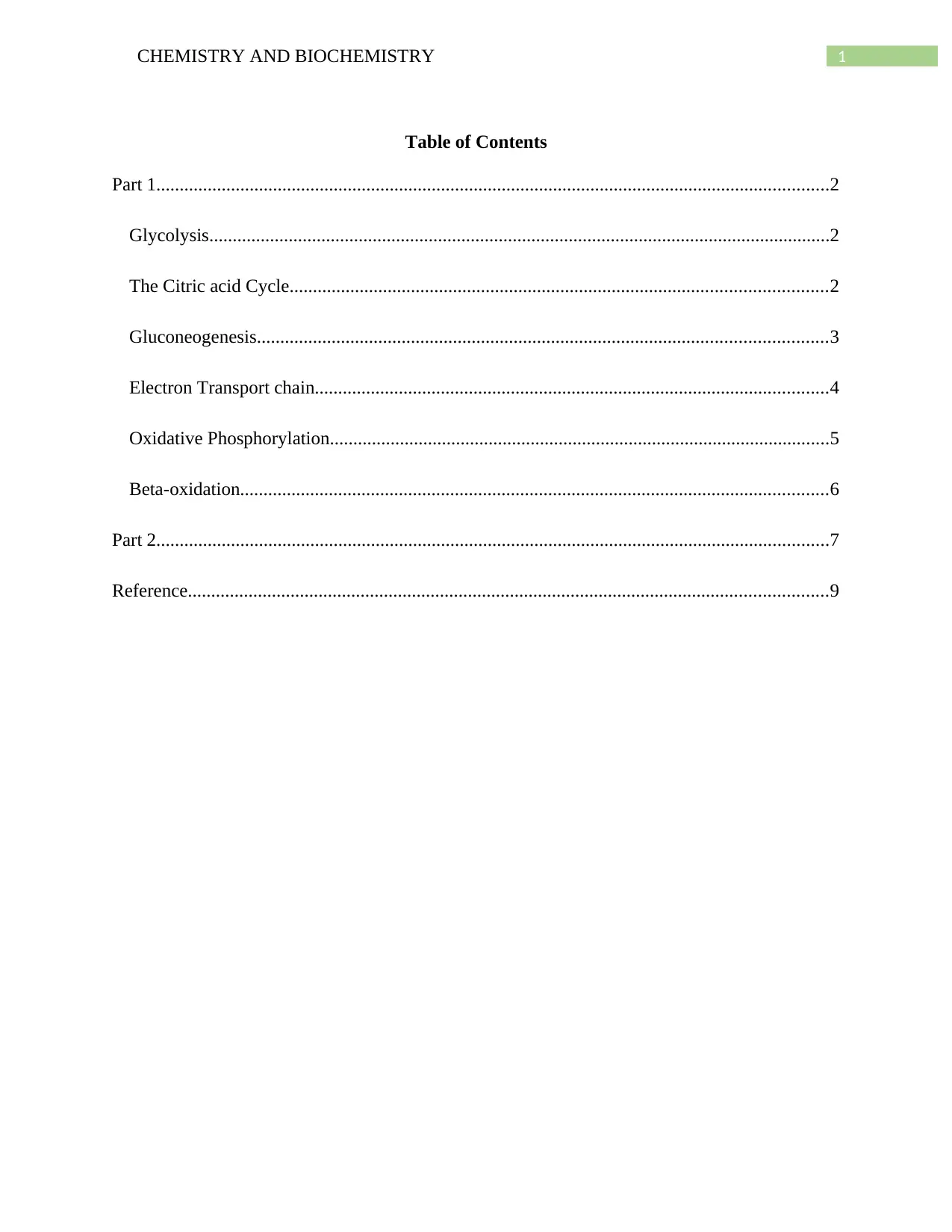
1CHEMISTRY AND BIOCHEMISTRY
Table of Contents
Part 1................................................................................................................................................2
Glycolysis.....................................................................................................................................2
The Citric acid Cycle...................................................................................................................2
Gluconeogenesis..........................................................................................................................3
Electron Transport chain..............................................................................................................4
Oxidative Phosphorylation...........................................................................................................5
Beta-oxidation..............................................................................................................................6
Part 2................................................................................................................................................7
Reference.........................................................................................................................................9
Table of Contents
Part 1................................................................................................................................................2
Glycolysis.....................................................................................................................................2
The Citric acid Cycle...................................................................................................................2
Gluconeogenesis..........................................................................................................................3
Electron Transport chain..............................................................................................................4
Oxidative Phosphorylation...........................................................................................................5
Beta-oxidation..............................................................................................................................6
Part 2................................................................................................................................................7
Reference.........................................................................................................................................9
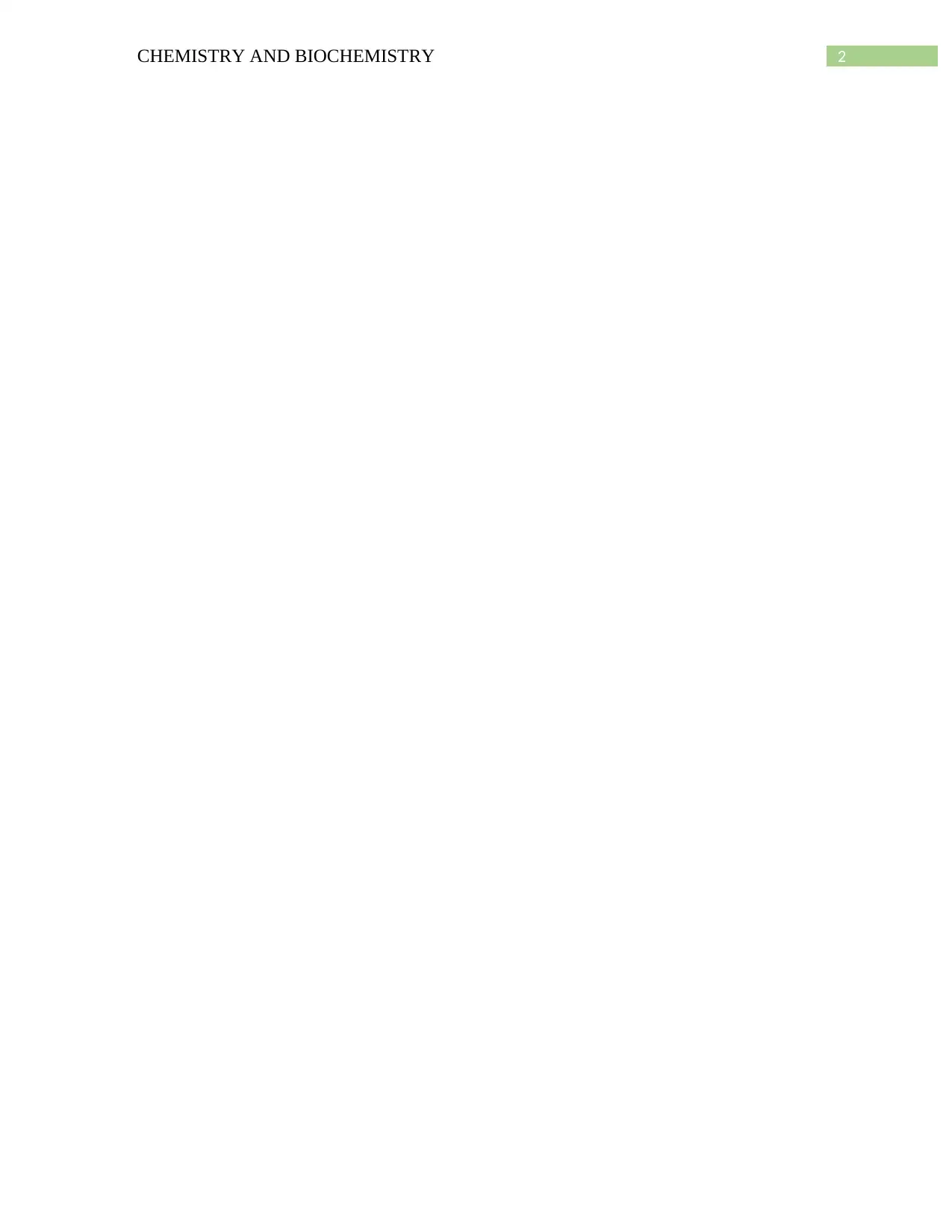
2CHEMISTRY AND BIOCHEMISTRY
⊘ This is a preview!⊘
Do you want full access?
Subscribe today to unlock all pages.

Trusted by 1+ million students worldwide
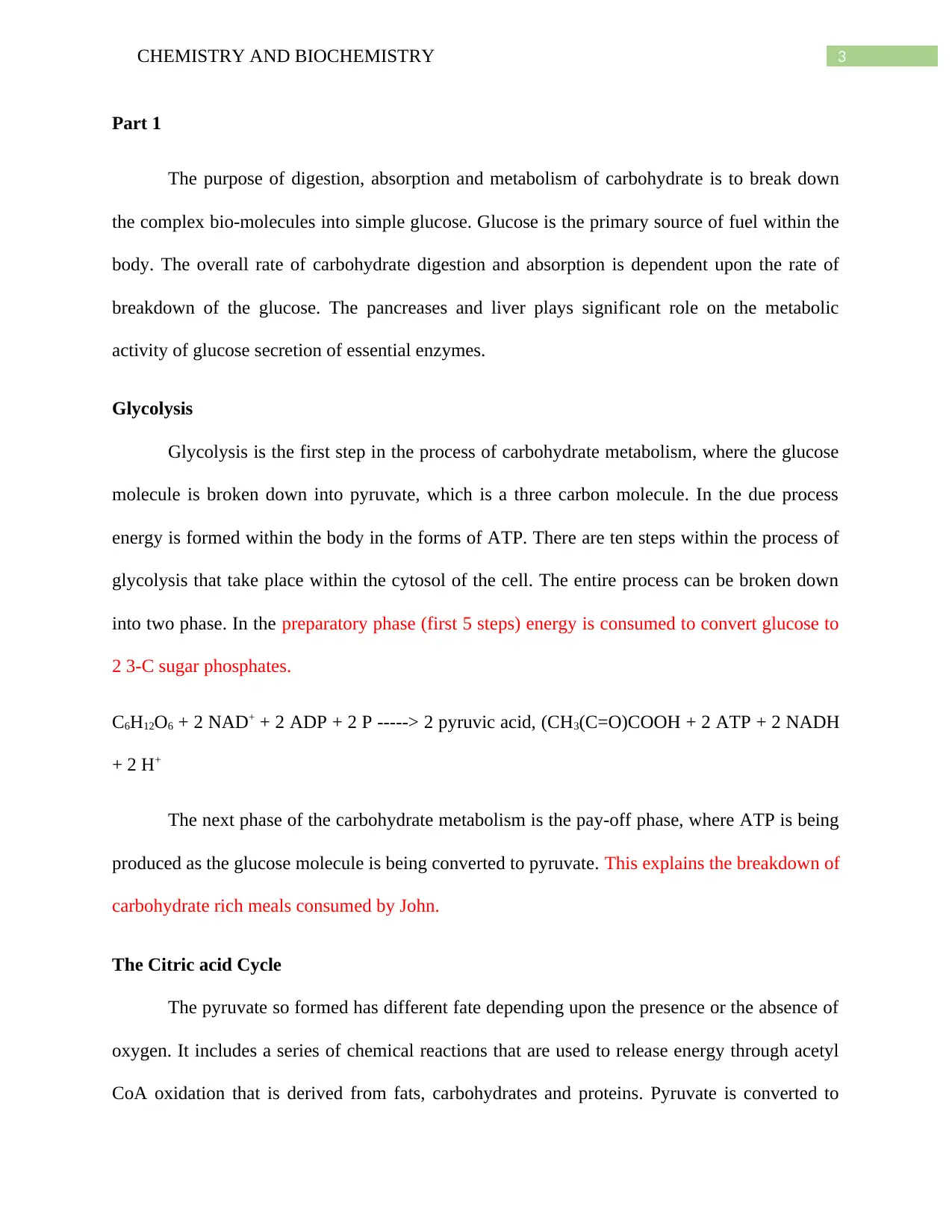
3CHEMISTRY AND BIOCHEMISTRY
Part 1
The purpose of digestion, absorption and metabolism of carbohydrate is to break down
the complex bio-molecules into simple glucose. Glucose is the primary source of fuel within the
body. The overall rate of carbohydrate digestion and absorption is dependent upon the rate of
breakdown of the glucose. The pancreases and liver plays significant role on the metabolic
activity of glucose secretion of essential enzymes.
Glycolysis
Glycolysis is the first step in the process of carbohydrate metabolism, where the glucose
molecule is broken down into pyruvate, which is a three carbon molecule. In the due process
energy is formed within the body in the forms of ATP. There are ten steps within the process of
glycolysis that take place within the cytosol of the cell. The entire process can be broken down
into two phase. In the preparatory phase (first 5 steps) energy is consumed to convert glucose to
2 3-C sugar phosphates.
C6H12O6 + 2 NAD+ + 2 ADP + 2 P -----> 2 pyruvic acid, (CH3(C=O)COOH + 2 ATP + 2 NADH
+ 2 H+
The next phase of the carbohydrate metabolism is the pay-off phase, where ATP is being
produced as the glucose molecule is being converted to pyruvate. This explains the breakdown of
carbohydrate rich meals consumed by John.
The Citric acid Cycle
The pyruvate so formed has different fate depending upon the presence or the absence of
oxygen. It includes a series of chemical reactions that are used to release energy through acetyl
CoA oxidation that is derived from fats, carbohydrates and proteins. Pyruvate is converted to
Part 1
The purpose of digestion, absorption and metabolism of carbohydrate is to break down
the complex bio-molecules into simple glucose. Glucose is the primary source of fuel within the
body. The overall rate of carbohydrate digestion and absorption is dependent upon the rate of
breakdown of the glucose. The pancreases and liver plays significant role on the metabolic
activity of glucose secretion of essential enzymes.
Glycolysis
Glycolysis is the first step in the process of carbohydrate metabolism, where the glucose
molecule is broken down into pyruvate, which is a three carbon molecule. In the due process
energy is formed within the body in the forms of ATP. There are ten steps within the process of
glycolysis that take place within the cytosol of the cell. The entire process can be broken down
into two phase. In the preparatory phase (first 5 steps) energy is consumed to convert glucose to
2 3-C sugar phosphates.
C6H12O6 + 2 NAD+ + 2 ADP + 2 P -----> 2 pyruvic acid, (CH3(C=O)COOH + 2 ATP + 2 NADH
+ 2 H+
The next phase of the carbohydrate metabolism is the pay-off phase, where ATP is being
produced as the glucose molecule is being converted to pyruvate. This explains the breakdown of
carbohydrate rich meals consumed by John.
The Citric acid Cycle
The pyruvate so formed has different fate depending upon the presence or the absence of
oxygen. It includes a series of chemical reactions that are used to release energy through acetyl
CoA oxidation that is derived from fats, carbohydrates and proteins. Pyruvate is converted to
Paraphrase This Document
Need a fresh take? Get an instant paraphrase of this document with our AI Paraphraser
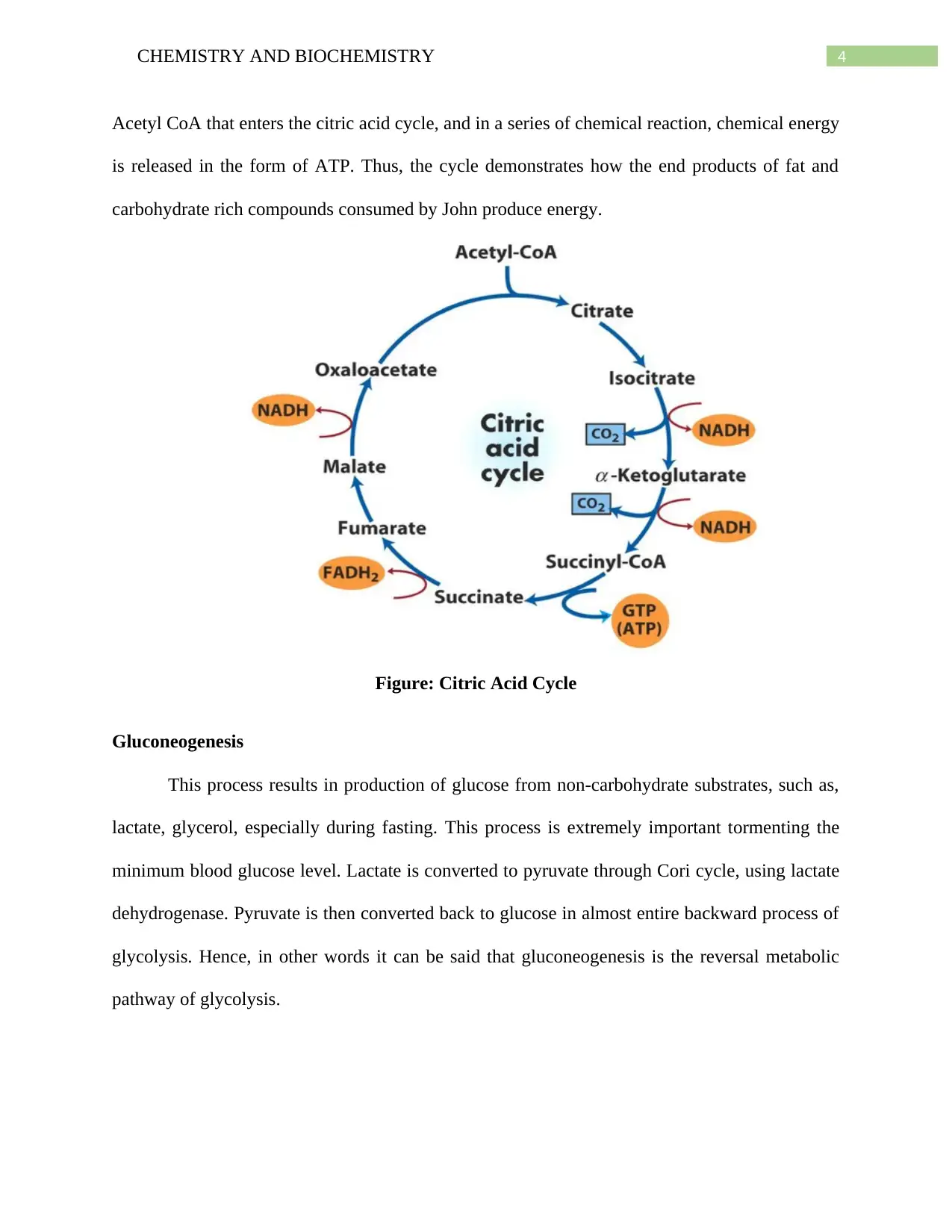
4CHEMISTRY AND BIOCHEMISTRY
Acetyl CoA that enters the citric acid cycle, and in a series of chemical reaction, chemical energy
is released in the form of ATP. Thus, the cycle demonstrates how the end products of fat and
carbohydrate rich compounds consumed by John produce energy.
Figure: Citric Acid Cycle
Gluconeogenesis
This process results in production of glucose from non-carbohydrate substrates, such as,
lactate, glycerol, especially during fasting. This process is extremely important tormenting the
minimum blood glucose level. Lactate is converted to pyruvate through Cori cycle, using lactate
dehydrogenase. Pyruvate is then converted back to glucose in almost entire backward process of
glycolysis. Hence, in other words it can be said that gluconeogenesis is the reversal metabolic
pathway of glycolysis.
Acetyl CoA that enters the citric acid cycle, and in a series of chemical reaction, chemical energy
is released in the form of ATP. Thus, the cycle demonstrates how the end products of fat and
carbohydrate rich compounds consumed by John produce energy.
Figure: Citric Acid Cycle
Gluconeogenesis
This process results in production of glucose from non-carbohydrate substrates, such as,
lactate, glycerol, especially during fasting. This process is extremely important tormenting the
minimum blood glucose level. Lactate is converted to pyruvate through Cori cycle, using lactate
dehydrogenase. Pyruvate is then converted back to glucose in almost entire backward process of
glycolysis. Hence, in other words it can be said that gluconeogenesis is the reversal metabolic
pathway of glycolysis.
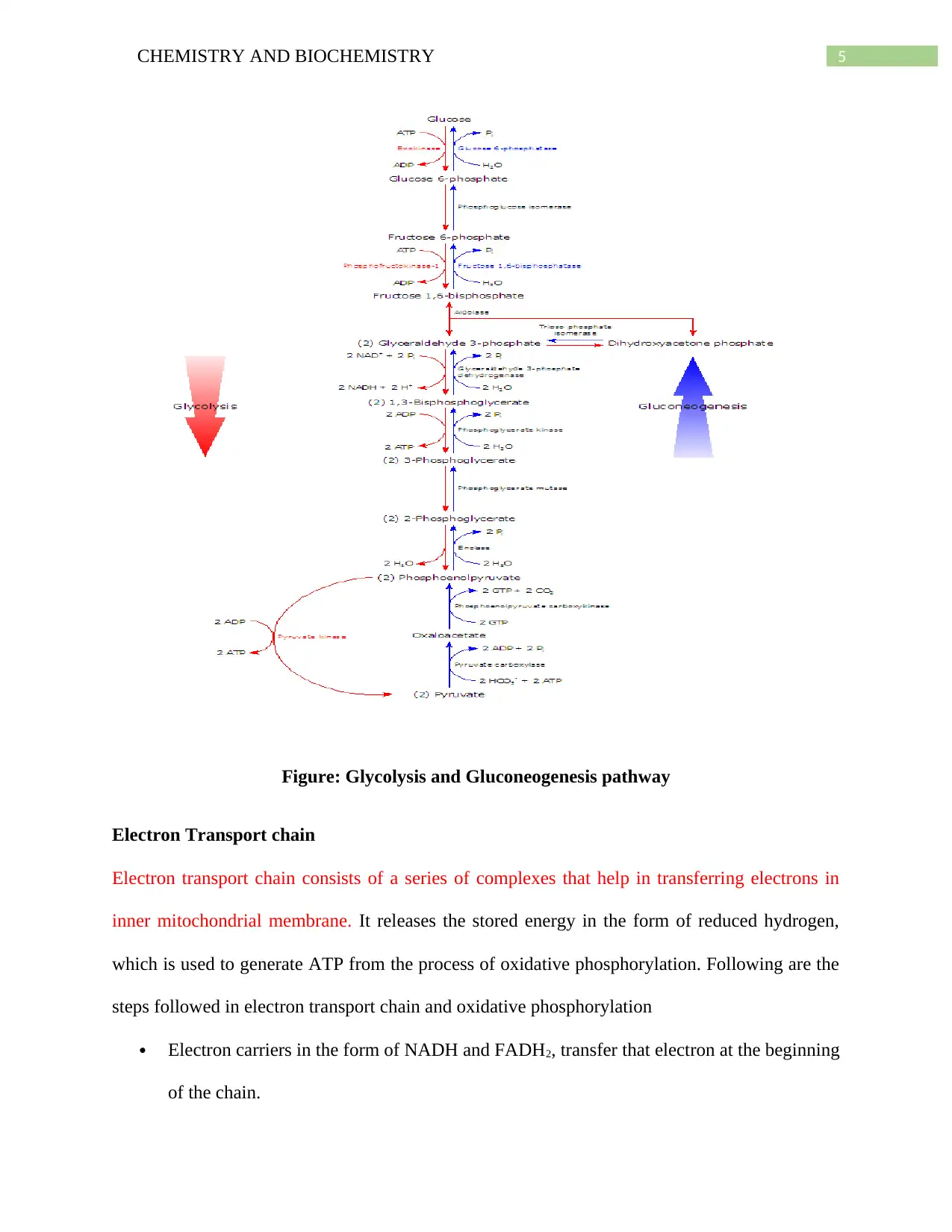
5CHEMISTRY AND BIOCHEMISTRY
Figure: Glycolysis and Gluconeogenesis pathway
Electron Transport chain
Electron transport chain consists of a series of complexes that help in transferring electrons in
inner mitochondrial membrane. It releases the stored energy in the form of reduced hydrogen,
which is used to generate ATP from the process of oxidative phosphorylation. Following are the
steps followed in electron transport chain and oxidative phosphorylation
Electron carriers in the form of NADH and FADH2, transfer that electron at the beginning
of the chain.
Figure: Glycolysis and Gluconeogenesis pathway
Electron Transport chain
Electron transport chain consists of a series of complexes that help in transferring electrons in
inner mitochondrial membrane. It releases the stored energy in the form of reduced hydrogen,
which is used to generate ATP from the process of oxidative phosphorylation. Following are the
steps followed in electron transport chain and oxidative phosphorylation
Electron carriers in the form of NADH and FADH2, transfer that electron at the beginning
of the chain.
⊘ This is a preview!⊘
Do you want full access?
Subscribe today to unlock all pages.

Trusted by 1+ million students worldwide
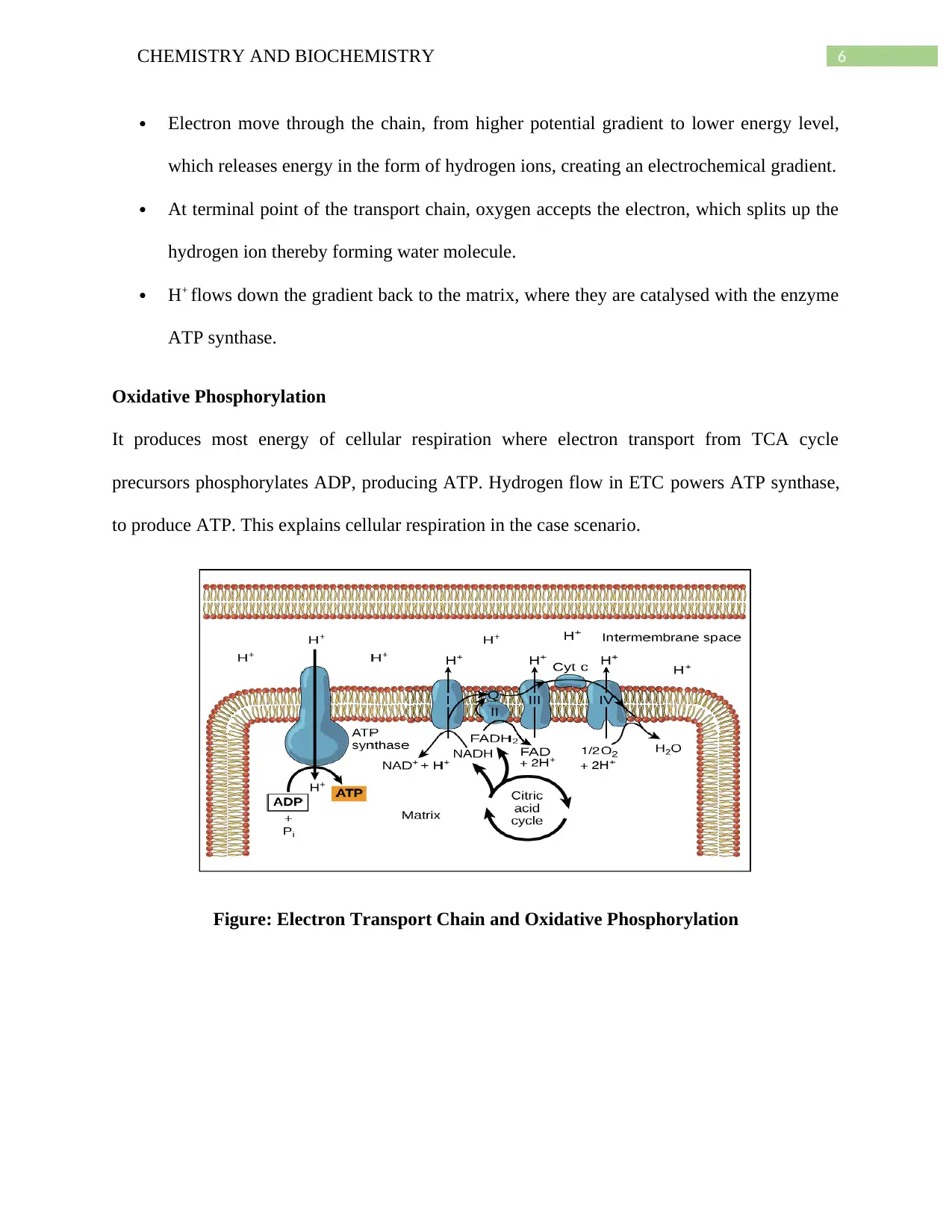
6CHEMISTRY AND BIOCHEMISTRY
Electron move through the chain, from higher potential gradient to lower energy level,
which releases energy in the form of hydrogen ions, creating an electrochemical gradient.
At terminal point of the transport chain, oxygen accepts the electron, which splits up the
hydrogen ion thereby forming water molecule.
H+ flows down the gradient back to the matrix, where they are catalysed with the enzyme
ATP synthase.
Oxidative Phosphorylation
It produces most energy of cellular respiration where electron transport from TCA cycle
precursors phosphorylates ADP, producing ATP. Hydrogen flow in ETC powers ATP synthase,
to produce ATP. This explains cellular respiration in the case scenario.
Figure: Electron Transport Chain and Oxidative Phosphorylation
Electron move through the chain, from higher potential gradient to lower energy level,
which releases energy in the form of hydrogen ions, creating an electrochemical gradient.
At terminal point of the transport chain, oxygen accepts the electron, which splits up the
hydrogen ion thereby forming water molecule.
H+ flows down the gradient back to the matrix, where they are catalysed with the enzyme
ATP synthase.
Oxidative Phosphorylation
It produces most energy of cellular respiration where electron transport from TCA cycle
precursors phosphorylates ADP, producing ATP. Hydrogen flow in ETC powers ATP synthase,
to produce ATP. This explains cellular respiration in the case scenario.
Figure: Electron Transport Chain and Oxidative Phosphorylation
Paraphrase This Document
Need a fresh take? Get an instant paraphrase of this document with our AI Paraphraser
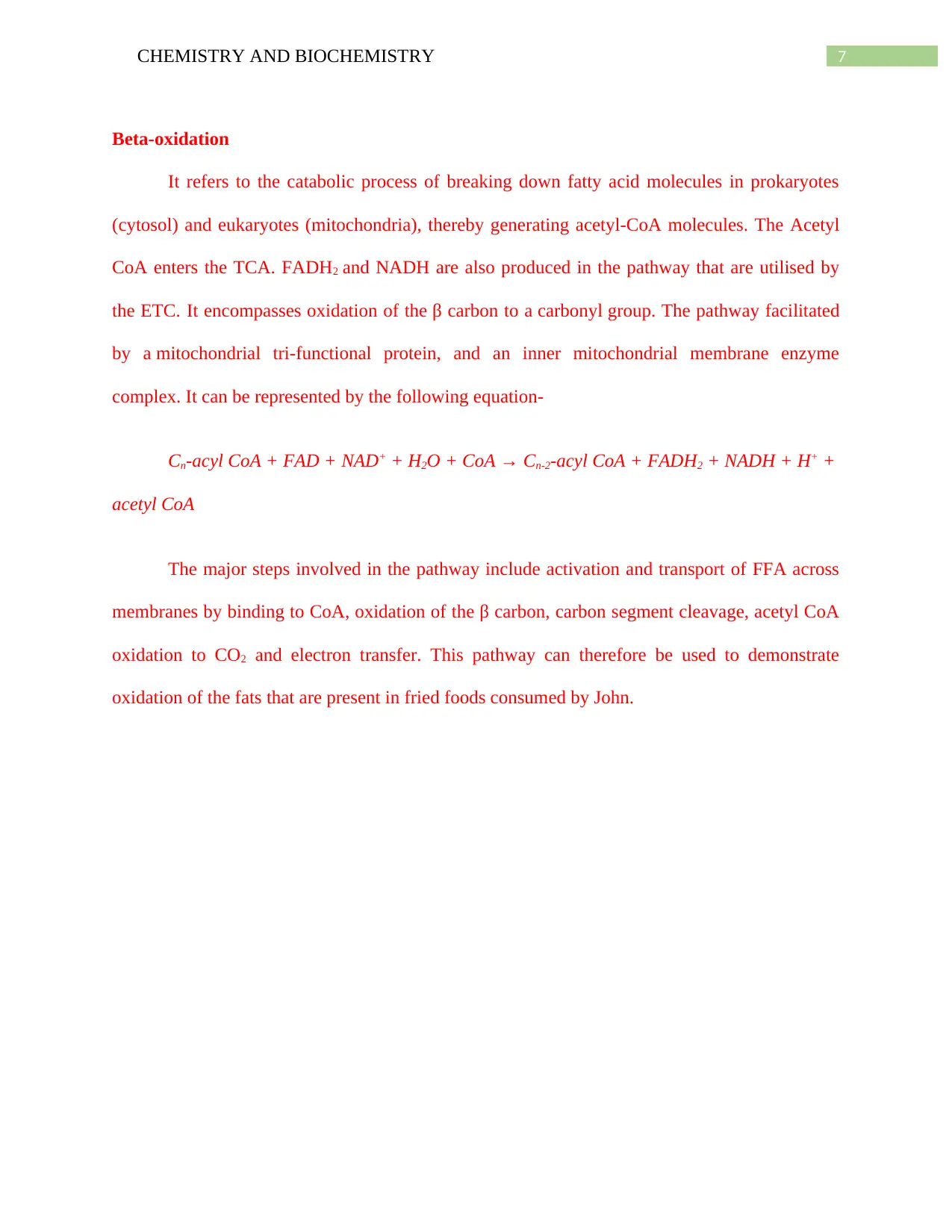
7CHEMISTRY AND BIOCHEMISTRY
Beta-oxidation
It refers to the catabolic process of breaking down fatty acid molecules in prokaryotes
(cytosol) and eukaryotes (mitochondria), thereby generating acetyl-CoA molecules. The Acetyl
CoA enters the TCA. FADH2 and NADH are also produced in the pathway that are utilised by
the ETC. It encompasses oxidation of the β carbon to a carbonyl group. The pathway facilitated
by a mitochondrial tri-functional protein, and an inner mitochondrial membrane enzyme
complex. It can be represented by the following equation-
Cn-acyl CoA + FAD + NAD+ + H2O + CoA → Cn-2-acyl CoA + FADH2 + NADH + H+ +
acetyl CoA
The major steps involved in the pathway include activation and transport of FFA across
membranes by binding to CoA, oxidation of the β carbon, carbon segment cleavage, acetyl CoA
oxidation to CO2 and electron transfer. This pathway can therefore be used to demonstrate
oxidation of the fats that are present in fried foods consumed by John.
Beta-oxidation
It refers to the catabolic process of breaking down fatty acid molecules in prokaryotes
(cytosol) and eukaryotes (mitochondria), thereby generating acetyl-CoA molecules. The Acetyl
CoA enters the TCA. FADH2 and NADH are also produced in the pathway that are utilised by
the ETC. It encompasses oxidation of the β carbon to a carbonyl group. The pathway facilitated
by a mitochondrial tri-functional protein, and an inner mitochondrial membrane enzyme
complex. It can be represented by the following equation-
Cn-acyl CoA + FAD + NAD+ + H2O + CoA → Cn-2-acyl CoA + FADH2 + NADH + H+ +
acetyl CoA
The major steps involved in the pathway include activation and transport of FFA across
membranes by binding to CoA, oxidation of the β carbon, carbon segment cleavage, acetyl CoA
oxidation to CO2 and electron transfer. This pathway can therefore be used to demonstrate
oxidation of the fats that are present in fried foods consumed by John.
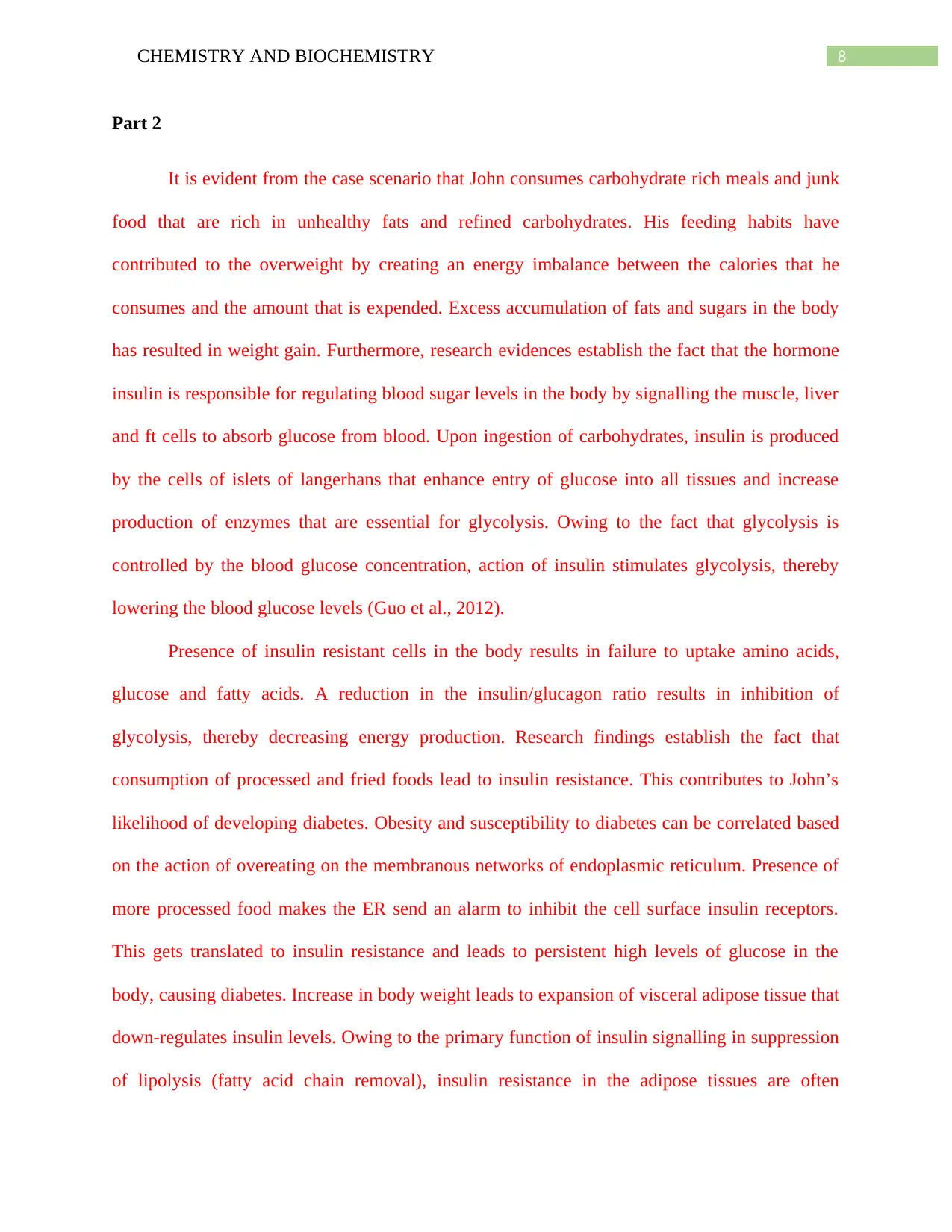
8CHEMISTRY AND BIOCHEMISTRY
Part 2
It is evident from the case scenario that John consumes carbohydrate rich meals and junk
food that are rich in unhealthy fats and refined carbohydrates. His feeding habits have
contributed to the overweight by creating an energy imbalance between the calories that he
consumes and the amount that is expended. Excess accumulation of fats and sugars in the body
has resulted in weight gain. Furthermore, research evidences establish the fact that the hormone
insulin is responsible for regulating blood sugar levels in the body by signalling the muscle, liver
and ft cells to absorb glucose from blood. Upon ingestion of carbohydrates, insulin is produced
by the cells of islets of langerhans that enhance entry of glucose into all tissues and increase
production of enzymes that are essential for glycolysis. Owing to the fact that glycolysis is
controlled by the blood glucose concentration, action of insulin stimulates glycolysis, thereby
lowering the blood glucose levels (Guo et al., 2012).
Presence of insulin resistant cells in the body results in failure to uptake amino acids,
glucose and fatty acids. A reduction in the insulin/glucagon ratio results in inhibition of
glycolysis, thereby decreasing energy production. Research findings establish the fact that
consumption of processed and fried foods lead to insulin resistance. This contributes to John’s
likelihood of developing diabetes. Obesity and susceptibility to diabetes can be correlated based
on the action of overeating on the membranous networks of endoplasmic reticulum. Presence of
more processed food makes the ER send an alarm to inhibit the cell surface insulin receptors.
This gets translated to insulin resistance and leads to persistent high levels of glucose in the
body, causing diabetes. Increase in body weight leads to expansion of visceral adipose tissue that
down-regulates insulin levels. Owing to the primary function of insulin signalling in suppression
of lipolysis (fatty acid chain removal), insulin resistance in the adipose tissues are often
Part 2
It is evident from the case scenario that John consumes carbohydrate rich meals and junk
food that are rich in unhealthy fats and refined carbohydrates. His feeding habits have
contributed to the overweight by creating an energy imbalance between the calories that he
consumes and the amount that is expended. Excess accumulation of fats and sugars in the body
has resulted in weight gain. Furthermore, research evidences establish the fact that the hormone
insulin is responsible for regulating blood sugar levels in the body by signalling the muscle, liver
and ft cells to absorb glucose from blood. Upon ingestion of carbohydrates, insulin is produced
by the cells of islets of langerhans that enhance entry of glucose into all tissues and increase
production of enzymes that are essential for glycolysis. Owing to the fact that glycolysis is
controlled by the blood glucose concentration, action of insulin stimulates glycolysis, thereby
lowering the blood glucose levels (Guo et al., 2012).
Presence of insulin resistant cells in the body results in failure to uptake amino acids,
glucose and fatty acids. A reduction in the insulin/glucagon ratio results in inhibition of
glycolysis, thereby decreasing energy production. Research findings establish the fact that
consumption of processed and fried foods lead to insulin resistance. This contributes to John’s
likelihood of developing diabetes. Obesity and susceptibility to diabetes can be correlated based
on the action of overeating on the membranous networks of endoplasmic reticulum. Presence of
more processed food makes the ER send an alarm to inhibit the cell surface insulin receptors.
This gets translated to insulin resistance and leads to persistent high levels of glucose in the
body, causing diabetes. Increase in body weight leads to expansion of visceral adipose tissue that
down-regulates insulin levels. Owing to the primary function of insulin signalling in suppression
of lipolysis (fatty acid chain removal), insulin resistance in the adipose tissues are often
⊘ This is a preview!⊘
Do you want full access?
Subscribe today to unlock all pages.

Trusted by 1+ million students worldwide
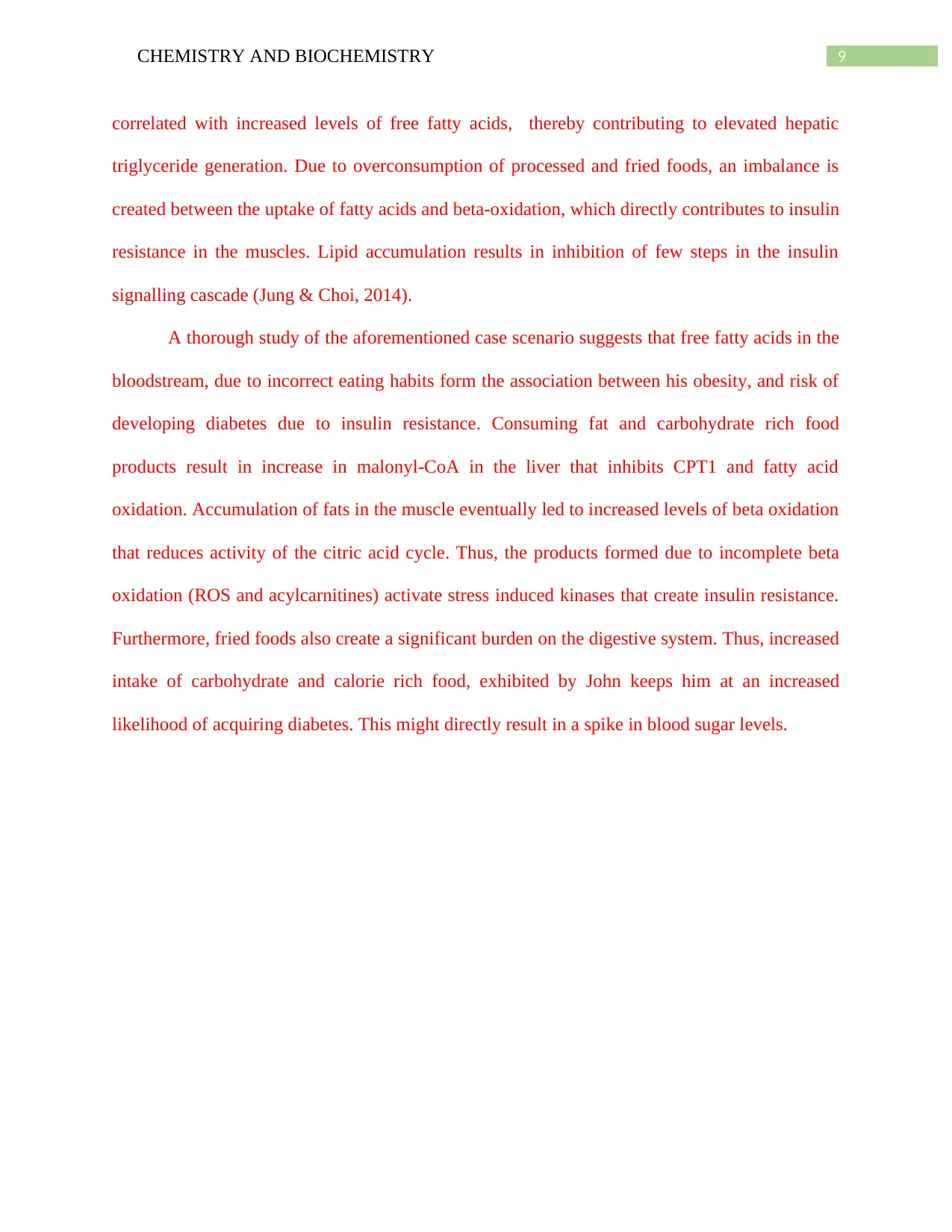
9CHEMISTRY AND BIOCHEMISTRY
correlated with increased levels of free fatty acids, thereby contributing to elevated hepatic
triglyceride generation. Due to overconsumption of processed and fried foods, an imbalance is
created between the uptake of fatty acids and beta-oxidation, which directly contributes to insulin
resistance in the muscles. Lipid accumulation results in inhibition of few steps in the insulin
signalling cascade (Jung & Choi, 2014).
A thorough study of the aforementioned case scenario suggests that free fatty acids in the
bloodstream, due to incorrect eating habits form the association between his obesity, and risk of
developing diabetes due to insulin resistance. Consuming fat and carbohydrate rich food
products result in increase in malonyl-CoA in the liver that inhibits CPT1 and fatty acid
oxidation. Accumulation of fats in the muscle eventually led to increased levels of beta oxidation
that reduces activity of the citric acid cycle. Thus, the products formed due to incomplete beta
oxidation (ROS and acylcarnitines) activate stress induced kinases that create insulin resistance.
Furthermore, fried foods also create a significant burden on the digestive system. Thus, increased
intake of carbohydrate and calorie rich food, exhibited by John keeps him at an increased
likelihood of acquiring diabetes. This might directly result in a spike in blood sugar levels.
correlated with increased levels of free fatty acids, thereby contributing to elevated hepatic
triglyceride generation. Due to overconsumption of processed and fried foods, an imbalance is
created between the uptake of fatty acids and beta-oxidation, which directly contributes to insulin
resistance in the muscles. Lipid accumulation results in inhibition of few steps in the insulin
signalling cascade (Jung & Choi, 2014).
A thorough study of the aforementioned case scenario suggests that free fatty acids in the
bloodstream, due to incorrect eating habits form the association between his obesity, and risk of
developing diabetes due to insulin resistance. Consuming fat and carbohydrate rich food
products result in increase in malonyl-CoA in the liver that inhibits CPT1 and fatty acid
oxidation. Accumulation of fats in the muscle eventually led to increased levels of beta oxidation
that reduces activity of the citric acid cycle. Thus, the products formed due to incomplete beta
oxidation (ROS and acylcarnitines) activate stress induced kinases that create insulin resistance.
Furthermore, fried foods also create a significant burden on the digestive system. Thus, increased
intake of carbohydrate and calorie rich food, exhibited by John keeps him at an increased
likelihood of acquiring diabetes. This might directly result in a spike in blood sugar levels.
Paraphrase This Document
Need a fresh take? Get an instant paraphrase of this document with our AI Paraphraser
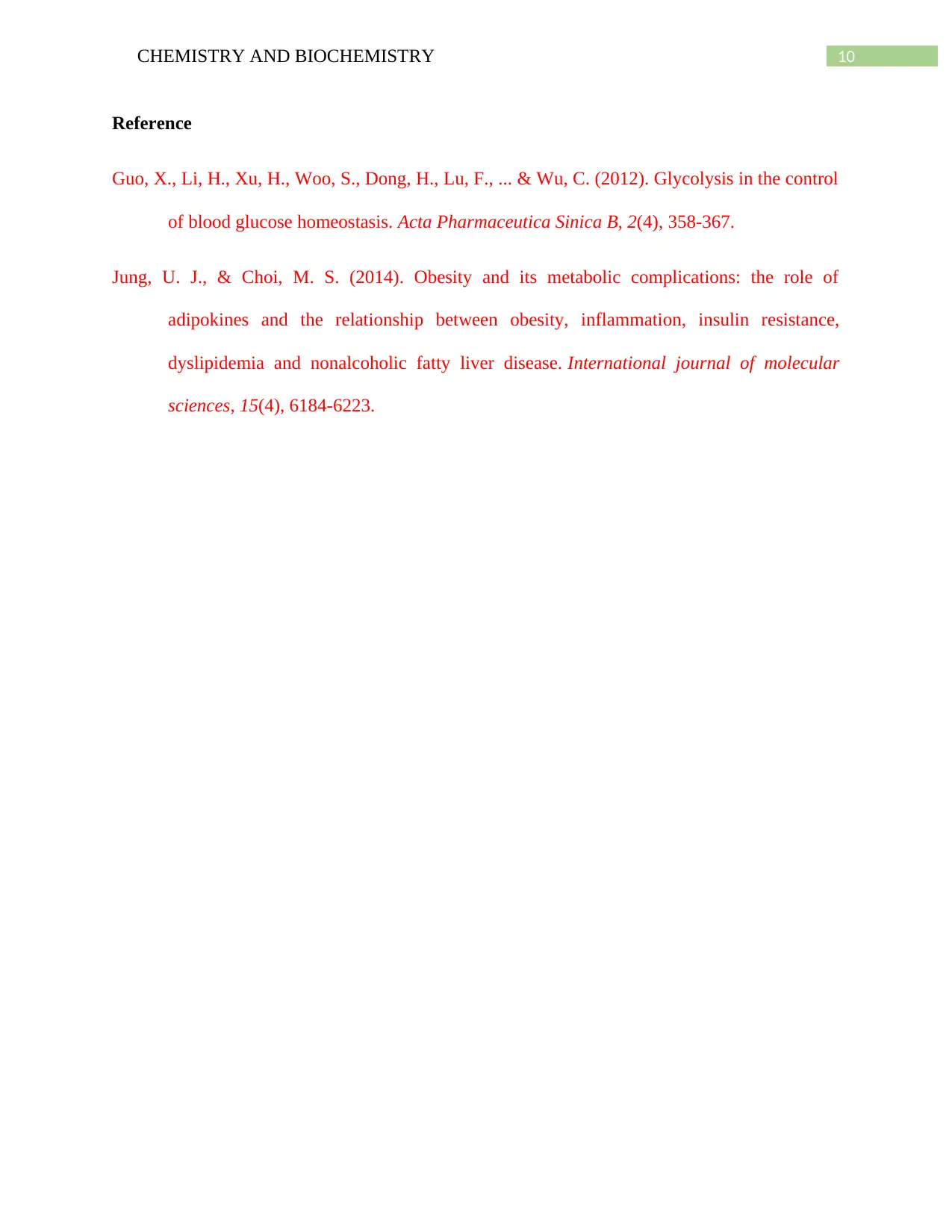
10CHEMISTRY AND BIOCHEMISTRY
Reference
Guo, X., Li, H., Xu, H., Woo, S., Dong, H., Lu, F., ... & Wu, C. (2012). Glycolysis in the control
of blood glucose homeostasis. Acta Pharmaceutica Sinica B, 2(4), 358-367.
Jung, U. J., & Choi, M. S. (2014). Obesity and its metabolic complications: the role of
adipokines and the relationship between obesity, inflammation, insulin resistance,
dyslipidemia and nonalcoholic fatty liver disease. International journal of molecular
sciences, 15(4), 6184-6223.
Reference
Guo, X., Li, H., Xu, H., Woo, S., Dong, H., Lu, F., ... & Wu, C. (2012). Glycolysis in the control
of blood glucose homeostasis. Acta Pharmaceutica Sinica B, 2(4), 358-367.
Jung, U. J., & Choi, M. S. (2014). Obesity and its metabolic complications: the role of
adipokines and the relationship between obesity, inflammation, insulin resistance,
dyslipidemia and nonalcoholic fatty liver disease. International journal of molecular
sciences, 15(4), 6184-6223.
1 out of 11
Related Documents
Your All-in-One AI-Powered Toolkit for Academic Success.
+13062052269
info@desklib.com
Available 24*7 on WhatsApp / Email
![[object Object]](/_next/static/media/star-bottom.7253800d.svg)
Unlock your academic potential
Copyright © 2020–2025 A2Z Services. All Rights Reserved. Developed and managed by ZUCOL.





